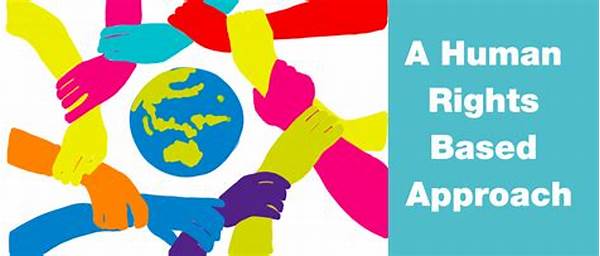In recent years, international development and humanitarian assistance have increasingly embraced the rights-based approach, a framework that prioritizes human rights at the heart of development interventions. This paradigm shift recognizes that individuals are central stakeholders in their own development, with entitlements and agency, rather than mere beneficiaries of aid. This article delves into the various facets of integrating a rights-based approach in aid.
The Foundation of Rights-Based Approach in Aid
The rights-based approach in aid emphasizes the importance of aligning development initiatives with international human rights standards. It requires that humanitarian strategies not only address the immediate needs of communities but also empower individuals to claim their rights. By prioritizing principles such as participation, accountability, and non-discrimination, this approach ensures that development efforts are equitable and inclusive. In practice, adopting a rights-based approach in aid means that aid agencies and organizations must actively engage with communities in decision-making processes, thus giving voice to marginalized groups. This engagement is pivotal in fostering locally-driven, sustainable solutions that respect the dignity and rights of individuals.
Implementing the Rights-Based Approach in Aid
1. Participation: The rights-based approach in aid mandates the active involvement of community members in all stages of aid implementation, ensuring their voices shape the interventions.
2. Accountability: Humanitarian organizations employing a rights-based approach in aid must hold themselves accountable to the population they serve, reinforcing transparency and trust.
3. Non-discrimination: Central to the rights-based approach in aid is ensuring all individuals, regardless of ethnicity, gender, or socio-economic status, have equal access to aid services.
4. Empowerment: The rights-based approach in aid focuses on fostering the capacities of individuals to advocate for their rights and participate in their community’s development.
5. Linkage to Human Rights Norms: This approach in aid explicitly integrates international human rights norms and standards into all aspects of aid planning and execution.
Challenges in Adopting a Rights-Based Approach in Aid
Despite its potential benefits, implementing a rights-based approach in aid is not without challenges. Organizations might encounter resistance when restructuring programs to align with human rights principles, as this often requires significant changes in their operational frameworks. Additionally, aligning aid with human rights standards may raise complex legal and political issues, especially in regions where governance structures are weak or rights are contested. Nevertheless, overcoming these hurdles is essential to advance equitable and sustainable development outcomes.
Furthermore, the rights-based approach in aid might demand more resources and capacities, both human and financial. Organizations must invest in training and capacity-building to equip their staff with the necessary skills to embed rights-focused perspectives effectively. The transition also requires building strong partnerships with local stakeholders, governments, and civil society to foster a supportive environment for rights-based development initiatives.
Success Stories of Rights-Based Approach in Aid
Several notable success stories highlight the impact of a rights-based approach in aid. For instance, programs focusing on women’s rights in rural areas have demonstrated significant improvements in community health and economic stability by empowering women to advocate for their rights and access resources. Collaborative efforts between international NGOs and local communities have resulted in sustainable agriculture projects, prioritizing food security and land rights. These examples underscore the transformative potential of incorporating human rights into development frameworks, leading to comprehensive and enduring solutions.
The rights-based approach in aid has also proven effective in emergency contexts. When applied to disaster relief operations, it not only addresses immediate needs but also prepares affected populations to claim their rights in the recovery phase. By drawing on these positive outcomes, humanitarian actors can develop more resilient and responsive systems that are well-equipped to withstand and recover from future challenges.
The Future of Rights-Based Approach in Aid
As global inequality and humanitarian crises persist, the future of the rights-based approach in aid is increasingly significant. Embracing this approach requires a commitment from the international community to uphold human rights as the cornerstone of aid delivery. This implies a continuous re-evaluation and adaptation of strategies to ensure they remain relevant and effective in addressing the evolving needs of communities worldwide. With the trend towards localization, a rights-based framework provides a robust foundation for empowering local actors to lead their development trajectories, ensuring aid interventions are rooted in the realities and aspirations of the people they serve.
The incorporation of technology and innovation in implementing a rights-based approach in aid also holds promise. Digital tools can enhance participation, improve efficiency, and enable real-time feedback mechanisms, offering new avenues for realizing human rights in development. As stakeholders collaborate to harness these advancements, the rights-based approach in aid can reach new heights, ensuring that development efforts are not only effective but also just and equitable.
Conclusion
In summary, the rights-based approach in aid represents a profound shift in how development and humanitarian interventions are conceptualized and implemented. By embedding human rights at the core, this approach endeavors to create a more just and equitable world where everyone can enjoy the full spectrum of rights. Despite the complexities involved in its adoption, the positive outcomes associated with the rights-based approach in aid underscore its potential as a transformative tool for sustainable development. As global challenges become more intertwined and persistent, integrating human rights into aid strategies remains crucial to achieving meaningful and lasting progress.





